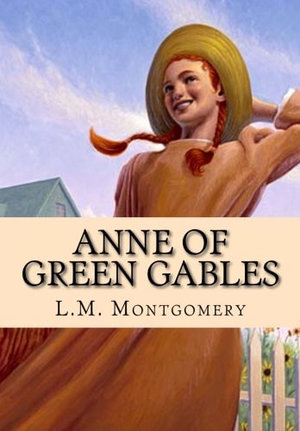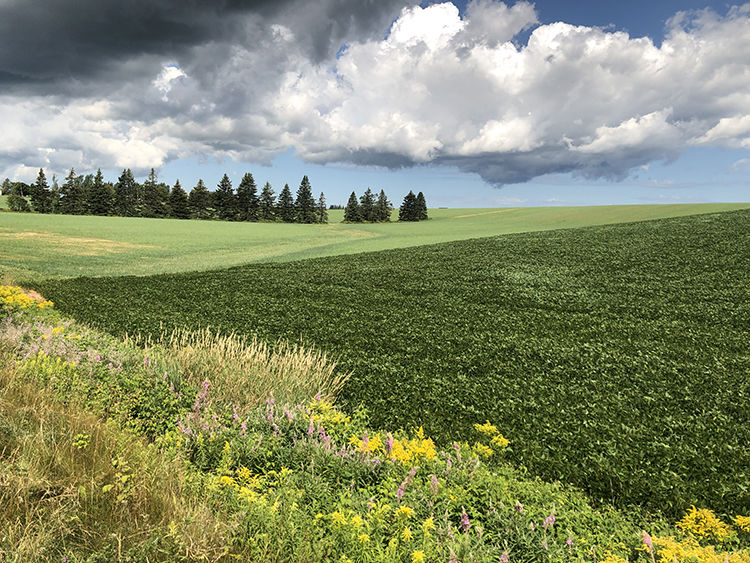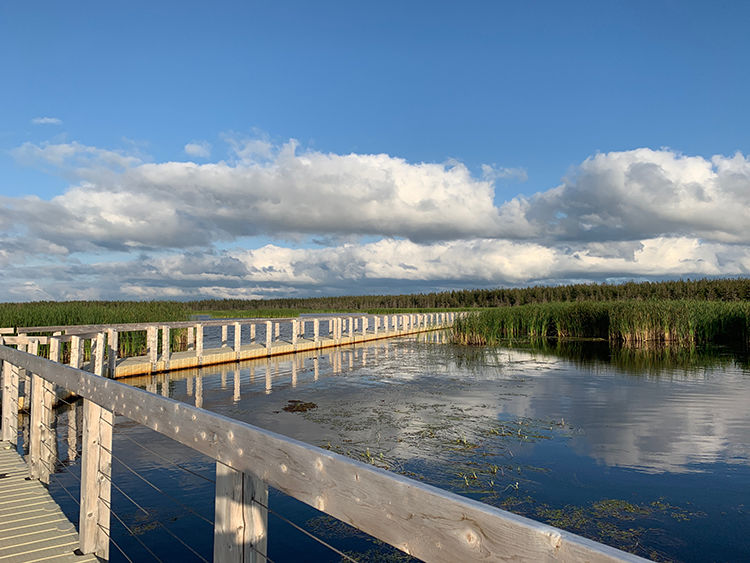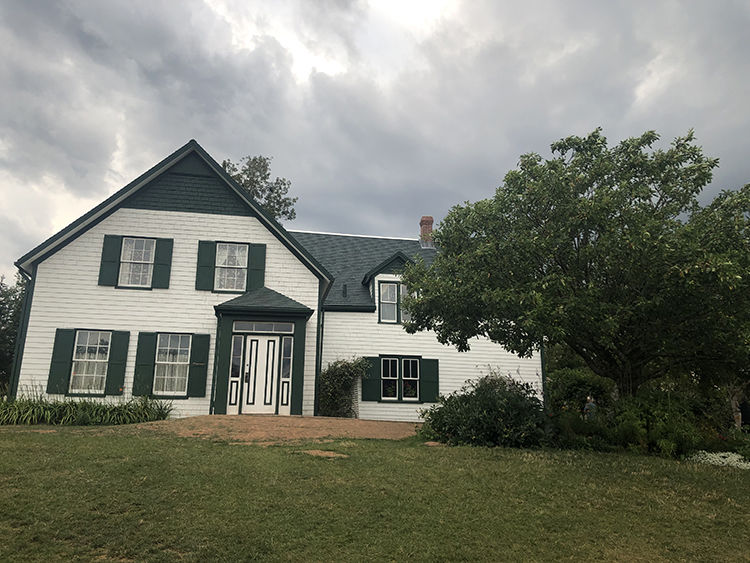I have wanted to visit Canada’s Prince Edward Island since I was 12 years old and first fell in love with Anne of Green Gables. As a tween, I read that book at least three times, and also read the seven additional books that make up the whole series. I knew that Anne (with an ‘e,’ which is how my middle name at the time read, too) was a fictional character, but I also knew that that the evocative setting of her life was not. While I could meet Anne Shirley only in my imagination, I could literally walk in the footprints of her imagined steps across the island that inspired Anne’s creator, Lucy Maud Montgomery.

It only took me 44 years to get there. Life, parenting and work get in the way, and suddenly you’re middle-aged, and your children are older than Anne was (11) in the first book. But my dream of visiting persisted, so when three fellow Domer women and I — who first befriended each other during our London semester in 1983 — batted around the idea of a bike excursion, I went for it. A pilgrimage to PEI seemed ideal, eh?
In preparation, we decided to reread the first book in the Anne series. Biking 50 to 60 kilometers each day for five days (a tour curated by PEI Cycling Tours) would take us past several pilgrimage sites, including Green Gables Heritage Place (a lovely national historic site), the Anne of Green Gables museum and Montgomery’s birthplace. We wanted to be ready.
First published in 1908, Anne of Green Gables was an “instant bestseller,” according to a sign at the heritage site. It turns out that much of Anne’s experience is based on her creator’s own lonely childhood. Montgomery’s mother died when she was a toddler, and her father moved across Canada to start a new family. Raised by her stern grandparents, Montgomery resorted to imaginary friends, which included her reflection in her grandmother’s china cabinet. (Anne describes a similar friend named Katie Maurice from her miserable pre-Green Gables days.)
Whose heart doesn’t go out to Anne Shirley? Initially, she is not only lonely and overworked by the families who keep her as a very young nanny, she is also unwanted. Then Marilla Cuthbert, a stiff spinster, and her agonizingly shy bachelor brother, Matthew, adopt Anne by mistake (they had wanted a boy to help around the farm). Throughout the novel, Marilla is so intent upon not spoiling her charge that Anne has no idea, at least as a child, that Marilla truly loves her. Montgomery’s novel carries a criticism of a Christianity that has rules and rods at its center, rather than love.

Landscapes such as this one along PEI's Confederation Trail form the backdrop to L.M. Montgomery's Anne series. Photos courtesy of the author.
Always seeking “scope for the imagination” (a term I loved as a child), Anne gets into mischief, most of it unintentional. When I realized that a well-remembered scene was coming, I couldn’t wait to read again how Anne accidentally served her best friend, Diana Barry, three glasses of Marilla’s homemade currant wine, thinking it was only “raspberry cordial.” Mrs. Barry is livid and forbids the girls’ “bosom friendship.” Only later, when Anne proves her calmness and competency in the face of any crisis and saves Diana’s younger sister, Minnie May, from the croup, does Mrs. Barry forgive her and allow Anne into their lives again.
Like another popular fictional orphan, Harry Potter, Anne creates her own magic, but not in a parallel world of wizards and witches. Her boundless imagination is the source of her magic. When she arrives in the fictional Avonlea (based on Cavendish, where Montgomery grew up), Anne evocatively renames places to reflect their inner magic: the Lake of Shining Waters, the Haunted Woods, Lover’s Lane. An avid reader, she later imagines herself to be Tennyson’s “Lady of Shalott” floating down to Camelot, and nearly drowns while reenacting it. Anne sees the world differently from most of us, encouraging readers to imagine life’s endless possibilities.

En route to the dunes at Greenwich National Park.
It’s gratifying to realize that your younger self had taste — even when the book you’re rereading is considered a classic mainly for young, female readers. While Montgomery’s memorable character has not inspired the number of retellings and spinoffs that Jane Austen’s certainly have, I find a lot of similarities in the two writers’ portrayals of small-town foibles and idiosyncrasies. Montgomery’s satirical depiction of certain characters — such as the nosy but well-meaning Mrs. Linde or the provincial Mrs. Barry — is mostly subtle and kind, but also quite amusing.
Did 12-year-old me appreciate the social comedy? I have to wonder as I chuckle at Mrs. Linde’s abiding distaste for Americans. And what about this wonderful introduction? “Here sat Marilla Cuthbert, when she sat at all, always slightly distrustful of sunshine, which seemed to her too dancing and irresponsible a thing for a world which was meant to be taken seriously.” Anne, of course, inspires Marilla to loosen up and enjoy life more.
Anne herself has faults galore, including her fiery temper and her persistent grudge against the handsome Gilbert Blythe for calling her “carrots.” But she also has a strong sense of justice and willingness to buck the system. Later in the series, when Anne becomes a teacher, she eschews corporal punishment (the accepted disciplinary tool of the time) and instead works hard to win the hearts and minds of her students.

Overlooking the Gulf of St. Lawrence from Cape Tryon: Amy Brecount White, Beth Fraser, Patti Kelly and Lisa Carrizales Revord, all Class of 1985.
As an author of fiction, I know the challenges of creating a setting that breathes and evokes. Rereading Anne, I understand why I’ve carried this strong desire to visit Prince Edward Island. While Montgomery’s eloquence may wax too poetic for some readers, particularly on the delights of nature, I found it inspirational and lovely.
Consider this scene: After a successful recitation (a popular form of entertainment in those days), the unworldly Anne and her girlfriends reflect on the pearls and diamonds they saw some of the attendees wearing. Anne insists on the richness of their own lives and experiences: “Look at that sea, girls — all silver and shadow and vision of things not seen. We couldn’t enjoy its loveliness any more if we had millions of dollars and ropes of diamonds.”
Attuned to reality and to her characters, Montgomery counters Anne’s exuberance with her friend Jane’s more practical observation that “diamonds would comfort a person for a good deal.” But Anne — both the character and the series — insists again and again on the lasting wealth that the world’s beauty, true friendship and a good book can bring us.

The house that inspired it all, at the Green Gables Heritage Place.
Anne of Green Gables shows how one vibrant life can radiate outward and change everything around it. Anne’s delight in the natural world and her fellow beings is contagious, and she transforms and uplifts everyone and everything in her path. She causes the reticent Matthew to blossom. At one point, Marilla wonders how she lived before Anne came into her life like a shining beam. And I am so very glad to have made Anne Shirley’s reacquaintance.
If you haven’t read Anne recently or — gasp — have never met her, add the novel to your pile. Better yet, read it out loud to your favorite tween and see the world through Montgomery’s lyrical and appreciative lens together.
As I rode my bike through the haystack-dotted farmlands and along PEI’s gorgeous coastline, I did my best to appreciate every blooming wildflower and every passing cloud in our path. Anne’s indomitable, kindred spirit and joie de vivre will continue to inspire my own adventures and bosom friendships.
Amy Brecount White writes about travel, education, families and gardening. She’s the author of Forget-Her-Nots (Greenwillow/ HarperCollins), a young adult novel about flower magic, and is wrapping up a women’s novel called Reality Bouquet.